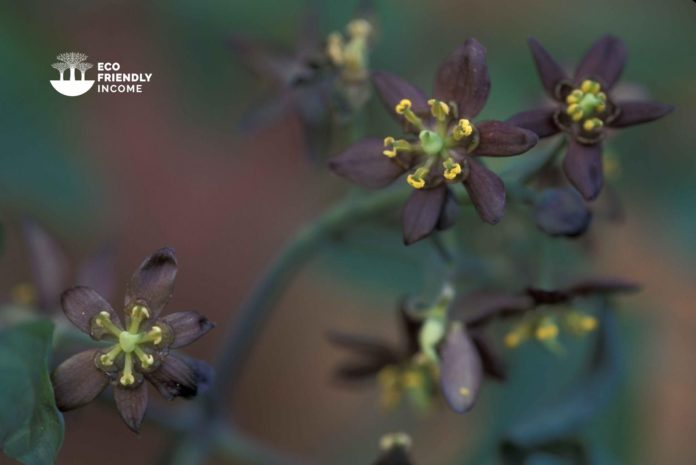Today’s plant is another North American native, Blue Cohosh. For conservation and commercial purposes, we’ll learn how to identify, use and propagate Blue Cohosh (Caulophyllum thalictroides).
It’s an interesting plant with curious flowers, a cousin to the well-known black cohosh. They’re often found growing in the mixed forests of eastern North America.
Cohosh is an Algonquin word that means rough, which is referring to the appearance of its roots.
The Algonquins knew of the medicinal properties of cohosh, and their knowledge still holds true to this day.
Roasted cohosh seeds also serve as an alternative to coffee beans, it has a similar flavor and enhances mental acuity.
The plant is a great choice in landscaping for people living in eastern North America since they’re native and non-invasive.
A good way to get accustomed to blue cohosh is to simply go out and forage for it. As long as you’re using sustainable foraging methods, and being careful, only good can come of it.
Of course, if we go out picking all of them, we don’t really give them a chance to flourish.
Instead what we can do is to bring some home to propagate ourselves.
Here’s what you can expect to learn in this article:
- Blue Cohosh Picking Season
- How to Identify Blue Cohosh
- Where You Can Find it
- How to Harvest it Sustainably
- How to Use & Store it
- How to Propagate Blue Cohosh
Let’s get started!
Blue Cohosh Picking Season
Blue cohosh root is usually harvested in late fall when the medicinally active components are at their peak. The best time to pick them is from late August to October before the first frost.

Harvesting blue cohosh seeds for propagation and coffee is done from late August to October as well.
How to Identify Blue Cohosh (Caulophyllum thalictroides)
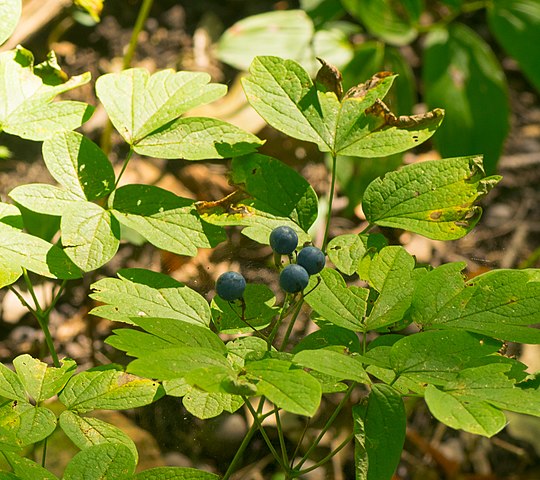
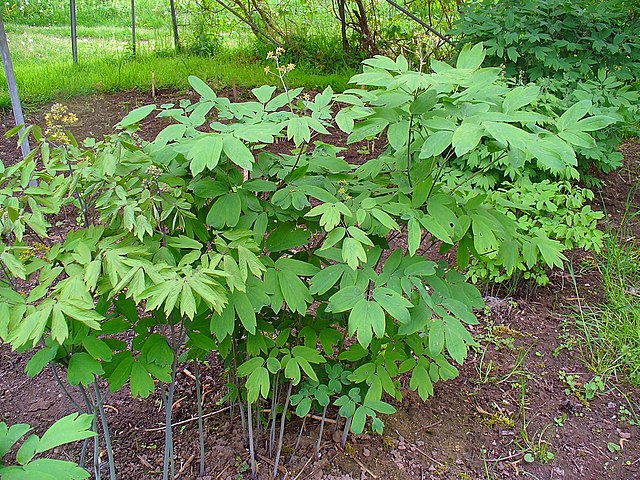
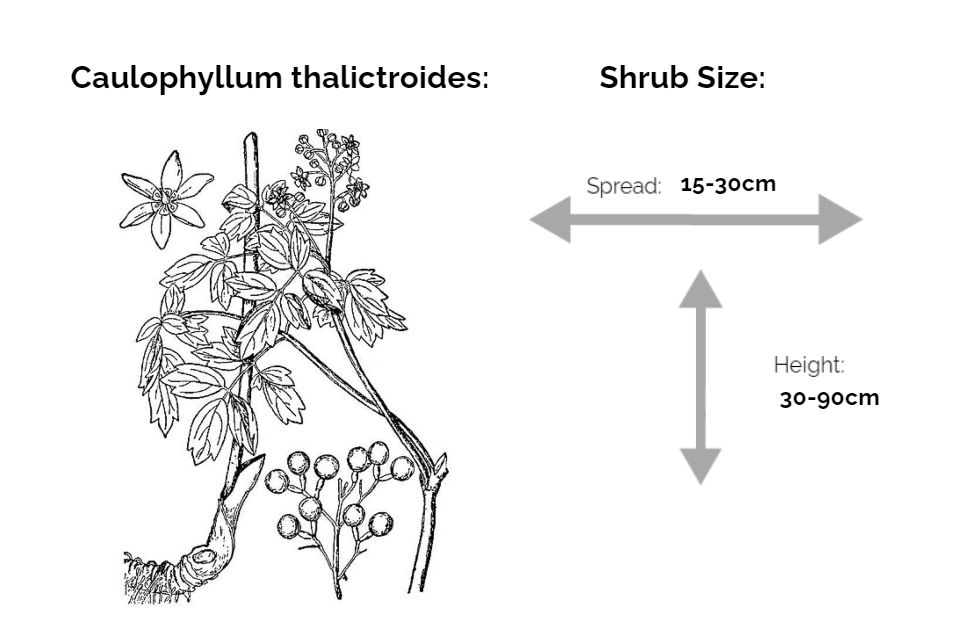
Blue Cohosh (Caulophyllum thalictroides) is a perennial shrub from North America native to mixed forests. It likes to grow in the understory and prefers shady, moist areas.
Flowers
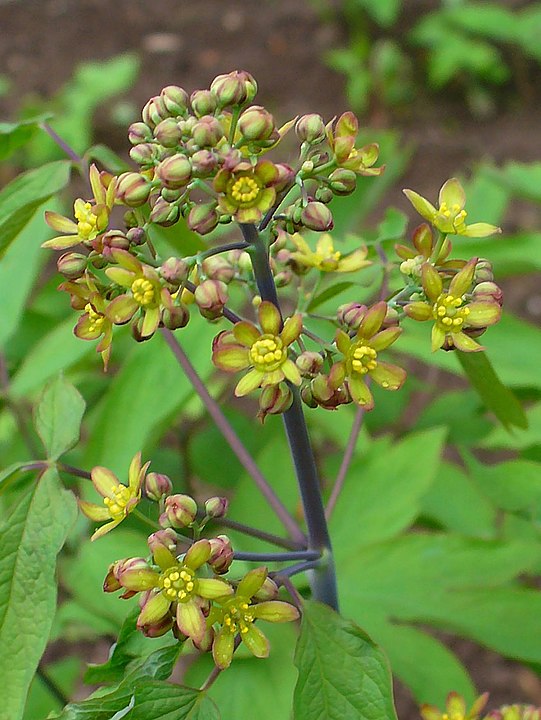
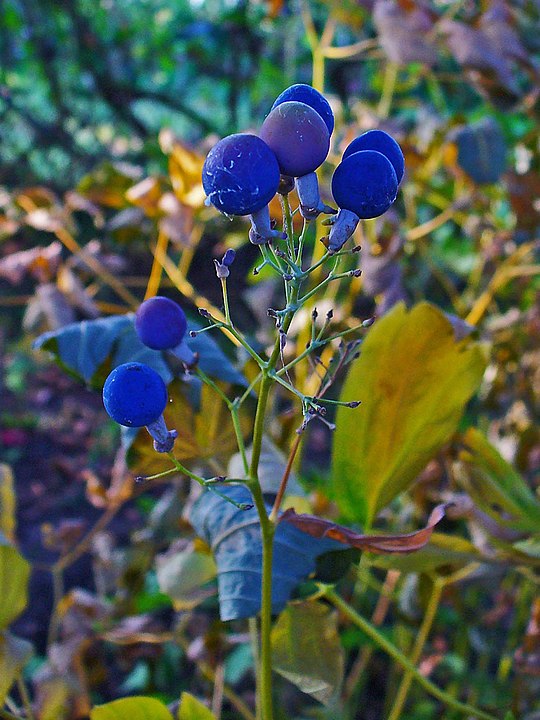
Individual flowers are about 1/3″ (8 mm.) across, consisting of 6 petaloid sepals, 6 stamens, and an ovoid ovary with a beak-like style.
The curious part is that what we actually see on blue cohosh flowers are not the petals but the sepals and stamens.
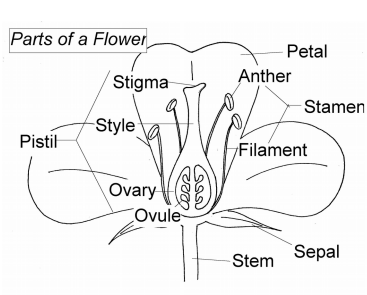
On blue cohosh, the sepal colors range from greenish-yellow, greenish-brown, or greenish-purple. The color depends on where it’s growing geographically and which distinct population you look at.
Their flowers appear mid to late spring before the leaves fully develop.
Afterward, the flowers turn into seed pods, which are initially green but turn bright blue at full maturity.
Leaves
Blue cohosh leaves are ovate to fan-shaped, have entire margins, and grow in a tripinnate structure.
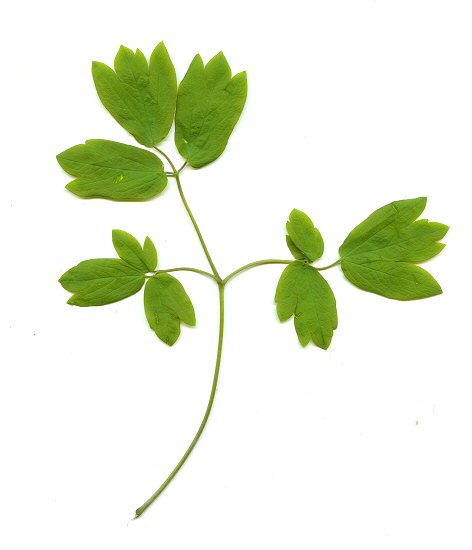
The main stem branches off into different limbs with a single leaf at each end and a pair or two of compound leaves growing down their lengths.
If you look closely, you will see the edges of the leaves are smooth, with exception of the ends that grow into ‘dinosaur toes’.
Where You Can Find Wild Blue Cohosh
You can find blue cohosh growing in undisturbed mixed forests. A good place to look is in rich mesic woodlands, bluffs, and wooded slopes of large ravines
It’s a native plant to the Appalachian mountain range. They also spread as far north as Canada in Ontario and southern Quebec. Here’s a map of where they grow: USDA PLANTS MAP.
Blue Cohosh (Caulophyllum thalictroides) likes to grow in the understory of forests dominated by the following trees:
- White Oak (Quercus alba) & Red Oak (Quercus borealis)
- Sugar Maple (Acer Saccharum) & Red Maple (Acer Rubrum)
While the plant grows conservatively, there’s a good chance you’ll find some growing in forests dominated by oaks and maples.
How to Harvest Blue Cohosh Plants Sustainably
Since the part of the plant that’s most useful is the rhizomatous root, you’ll have to dig out the plants to use them.
The U.S. Forest Department researched a method of determining root mass without digging destructively first. Read about it here: Sustainable Harvesting Blue Cohosh.
They made a formula you can use to predict underground root mass with what you see from the plant mass above ground.
My personal method for picking blue cohosh sustainably:
- Pick a plant that’s alone, the colonies grow tightly together, and it’s hard to take only one out without damaging the rest.
- Dig around the plant to find the rhizome.
- Snip the rhizome apart from the colony, you’ll have a clump with a big bundle of smaller roots.
- Leave the colony alone and try to find another with individual plants separate from the colony.
It’s simple, taking one plant per colony will minimally harm the patch, and it’ll continue to thrive.
You might have to cut the thick rhizomes with a knife to separate them. That’s fine because the plants can actually continue to grow when they’re divided.
How to Use & Store Freshly Picked Blue Cohosh
Blue Cohosh Uses
The Indigenous people of North America used cohosh roots to activate contractions when giving birth.
Additionally, it was made into decoctions to treat muscle and joint aches.
To this day, blue cohosh is still used by wise women in decoctions and tinctures to improve birthing process and expulsion of the placenta.
Blue Cohosh vs. Black Cohosh
Cohosh is a herb that is especially useful for the female reproductive system.
The difference between blue cohosh and black cohosh:
- Black cohosh is most useful to relieve menstrual cramps and symptoms of hormonal imbalance during menopause.
- Blue cohosh is most useful to ready the uterus to allow easier laboring during childbirth.
Blue Cohosh Medicinal Properties
- Analgesic (Relieves pain)
- Anti-inflammatory (Reduces inflammaton)
- Immunostimulating (Stimulates the immune system)
- Ocytocic (Stimulates contractions of the uterus)
How to Dry & Store Them
To conserve for later use, blue cohosh roots need to be dried and stored properly.
First, you want to air dry them. Separate them and place them somewhere to dry.
At home, what I did was build a drying rack for herbs and mushrooms. Here’s how I did it:
- I built three rectangular frames out of 1×3 wood.
- I bought some patio door screeners, cut them to the size of the frames, and stapled them on.
- Built some legs for the frames and I just stack the frames on top of each other.
Pretty simple, this way I got three levels on the rack to dry stuff. I leave it by a well-lit window and air-dry my herbs there.
The area needs to be well-lit but not have direct sunlight for too long, this could bleach your harvest.
It can take anywhere from a few days to a week to fully dry. Then you can use a pestle and mortar to grind them into powder or just store them as is.
Finally, place the powder or roots in a sealed mason jar, and store them away in a cool dark place.
How to Prepare
It’s recommended to take blue cohosh only in small doses, from fresh or dried roots. Here’s how to make a decoction:
- Clean and brush off any dirt from your roots, and place about 15g of blue cohosh per 1L of water.
- Bring to a boil for 3-4 minutes, then reduce heat and let macerate.
How to Use
Drink 250ml of the decoction, 3 times a day before eating when dealing with overdue birth or muscle/joint pain.
Where to Buy Blue Cohosh Extract Online
Alternatively, you can buy blue cohosh extract online at mountainroseherbs and follow their recommended dosage.
How to Propagate Blue Cohosh (Caulophyllum thalictroides)

Hardiness Zone: 3-8

Soil Type: Well-drained humus-rich, organic clay or loam.

Water: Medium-high. Likes constantly moist soil.

Exposure: Partial to Full Shade
Blue Cohosh (Caulophyllum thalictroides) is a shade-loving perennial shrub. It should be planted in consistently wet, slightly acidic clay or loam soils.
Commercial Value
Propagating blue cohosh is possible and it has some potential commercial value. The roots hold medicinal properties, and the seeds can be roasted to make a coffee alternative.
Additionally, it’s a native plant that is useful in landscaping to attract fauna. They produce pollen and nectar which are available as floral rewards to insect visitors.
Growing and propagating this plant is possible if you have the right environment. Let me show you how:
The Best Way to Propagate Blue Cohosh Plants:
Division
Blue cohosh can be propagated by root crown division and by dividing the rhizomes.
The best time to take blue cohosh rhizome cuttings is late Fall when the plant is dormant.

Crown Division
- Find a wild patch and identify the largest plant.
- Try to pull the plant out, if there’s resistance, look at where the roots go and try to dig them out.
- Once you have the plant out, you can split the root crown by hand or with a sharp knife from top to bottom.
- Make sure both sides have enough roots before you divide.
- Now take a good look at your divided plants, remove any dead or diseased foliage.
- Repot the two individually and water thoroughly until they are established.
Dividing the Rhizomes
Dividing the rhizomes successfully will require two steps: Digging out & Stratifying
- Find a large plant and inspect its surrounding roots.
- Some roots will go horizontally and new shoots come out further down, those are the rhizomes.
- Use a digging spade to dig 3-4 inches down to find the rhizomes.
- Lift a rhizome strand out of the ground, and cut into 2 inch pieces.
- Store the cuttings in a moist plastic bag for transport.
Rhizomes taken at this time of year will need to go through stratification to successfully sprout.
Overwinter Stratification
- At home, get some pots ready for the winter dormancy. For fuller plants, you want at least 2 cuttings per pot.
- Fill your pots with horticultural grade vermuculite, or alternatively metro mix 510 growing medium.
- Water them thoroughly and then place them in a cooler or minimally heated hoop house.
- Let them rest for 2-3 months, going through a cool period like this will help break dormancy once spring arrives.
When your blue cohosh cuttings have gone through this stratification period, you can now take them out in warm spring weather or bring them into a warm greenhouse.
From there, it should take one to two weeks for fresh leaves to sprout from your cuttings.
Finally, within six weeks, the cohosh rhizome cuttings should have developed into strong liners. These plants themselves can be a great source of rhizomes within 2-3 years.
Any other plant that’s grown to be sold commercially should be transplanted into 1 to 2-gallon pots. Within a year or two they’ll grow large enough to be sold in stores.
Liner Soil & Fertilizer
For this stage of the plant, a different type of soil is required:
Well-rotted compost is best when you plant, then side dress it with compost throughout the year.
Mulch the plants with leaves throughout the year to reproduce the forest condition, this will help keep the soil moist.
FAQ
Q: Is Blue Cohosh Poisonous?
A: The leaves & seeds contain the alkaloid methylcytisine, which is poisonous to humans, dogs, and cats in high doses.
Conclusion
If you live in North America and it’s a native plant to your area, I highly recommend using it as a landscaping plant.
Truth is, many of the landscaping plants we buy at garden centers end up being invasive. This means they spread to forests and compete with native plants.
This can lead to some species getting completely wiped out in areas.
This is why I encourage people to plant and propagate blue cohosh in their area only if it’s a native plant.
I hope I covered everything you need in this guide to serve that very purpose.
Let’s get propagating!

